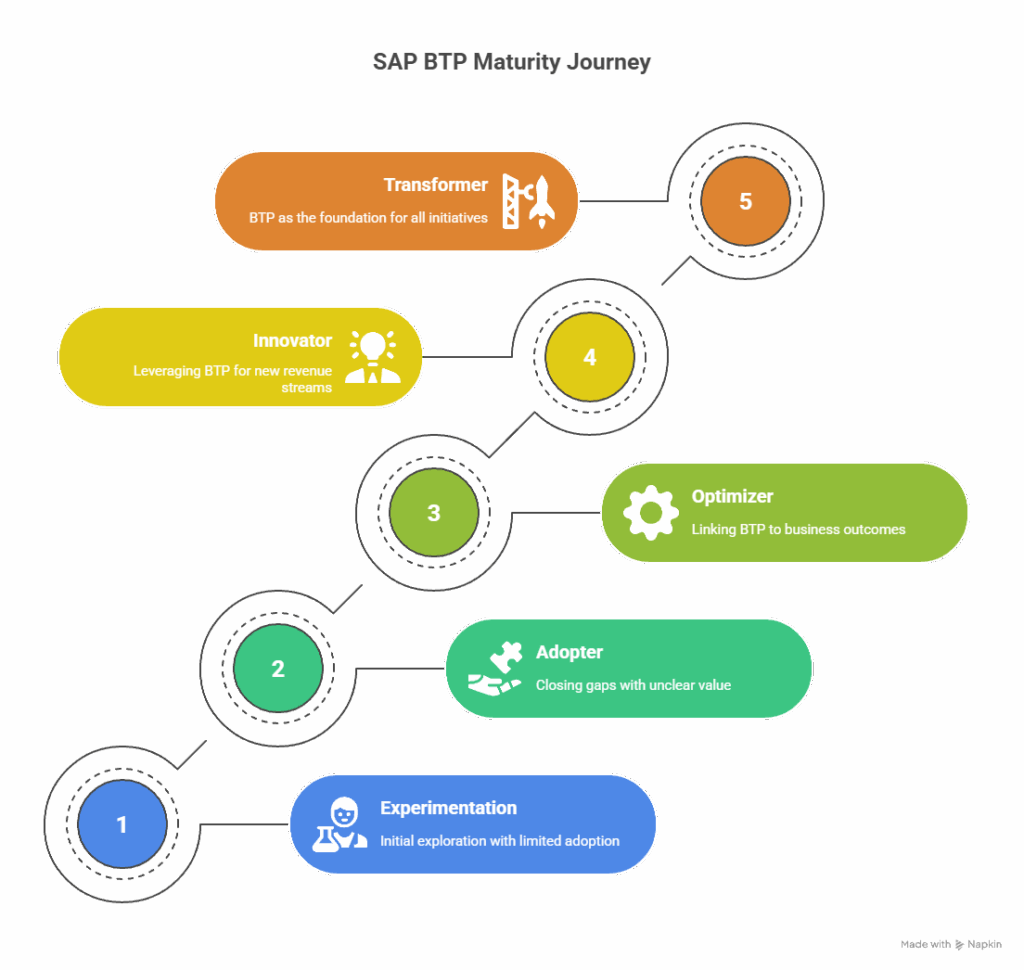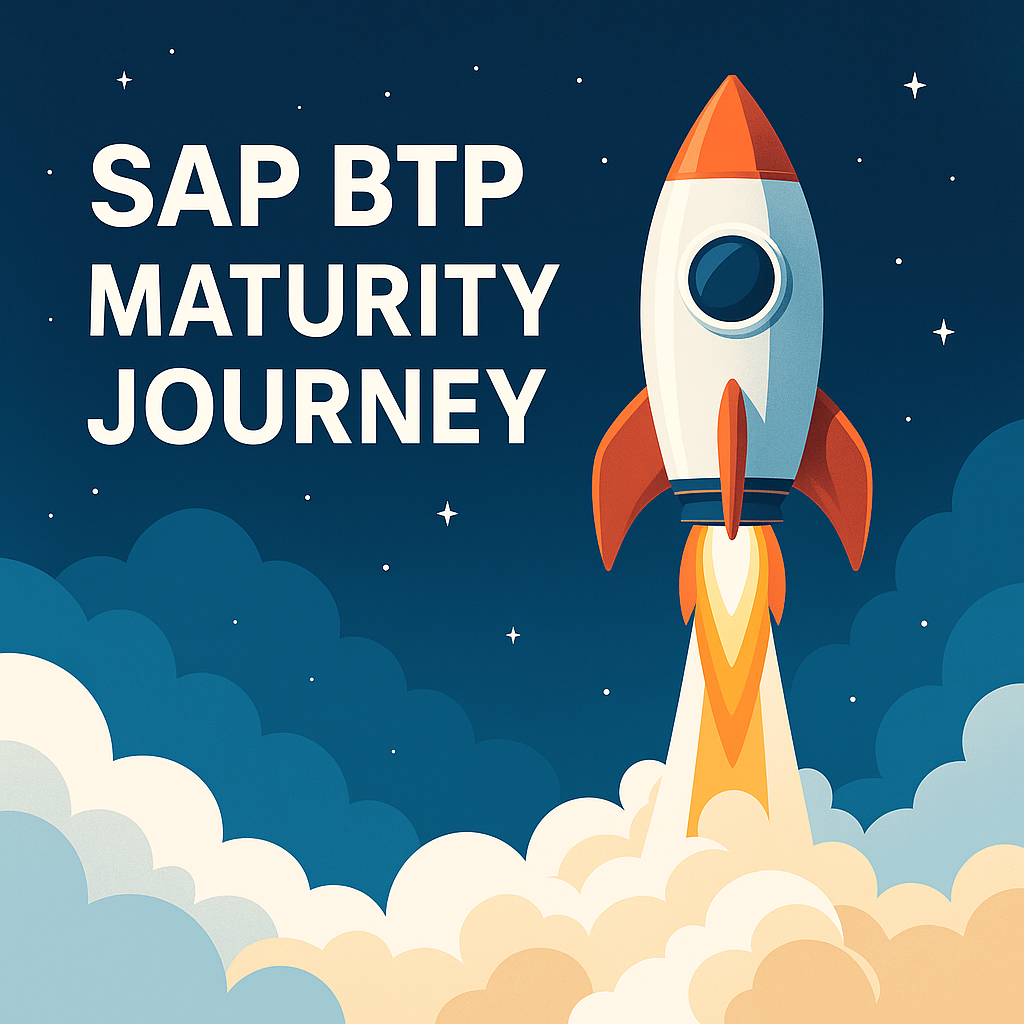Every SAP customer today has heard about BTP. Many even have it bundled into their RISE or GROW contract. Yet in my work since over 12 years, guiding hundreds of companies across industries, I have seen the same pattern repeat. Everyone thinks they are on a journey with BTP, but most are not moving very far along the maturity curve.

It usually starts with experimentation. A small plays with a small app on SAP Build, automates a simple form, or builds a couple of Integrations. Everything here is typically at a POC stage or at the most a prototype with limited adoption, business value and long term plan in place. It is a safe way to get familiar, but the majority of these experiments remain isolated. Entitlements expire, pilots sit abandoned, and executives are clueless what the real value of BTP is. According to ASUG research, more than half of SAP users are already on BTP, but process complexity is the top reason they struggle to scale. That complexity is exactly what keeps so many companies stuck at the starting line.
Some make progress into what I call the adopter stage. Here, BTP is used to close gaps the core cannot handle, for example, regulatory and compliance, localization use cases, niche and differentiating business processes. Or they might deploy standard SAP or partner content on BTP. This is where I have seen customers extend S/4HANA or SuccessFactors to the last mile with side by side apps. The goals are achieved but the value is unclear, and the risk is hidden. Without governance, these fixes pile up and recreate the same technical debt that Clean Core was meant to eliminate. I wrote about this in detail in my piece on SAP Clean Core governance.
Then come the optimizers. They start linking BTP to business outcomes. Finance leaders run planning scenarios in SAP Analytics Cloud using Digital Board room, supply chain teams connect IoT feeds for example to optimize time out of refrigeration, HR automates approvals. The business begins to see efficiency gains, but usually only in silos. IT celebrates, but the CFO or COO still sees fragmented progress. This is where many organizations stall, even though an IDC study showed companies using BTP with S/4HANA achieved a 514 percent ROI in just three years, with payback in eight months. The opportunity is real, but so is the execution gap.
Only a small fraction move into true innovation. These are the companies that no longer treat BTP as a tool kit, but as their innovation engine. They embed AI into finance close, build sustainability dashboards, or create industry apps that open new revenue streams. This is where companies truly leverage the power of BTP to build something that they never thought was possible with SAP Technologies. Think of use cases such as blockchain based solution to track fishes from farm to table, coaching insights iPad app for NHL, or optimizing day to day production to eliminate waste in Retail Bakeries.
And then there are the transformers. For them, BTP is not optional. It is assumed. Every rollout, every acquisition integration, every reinvention program begins with BTP as the foundation. There is clear alignment at all levels regarding the importance and value that BTP provides and these are truly the organizations that are able to get maximum value and ROI out of their BTP investments. Governance, strategy, security, and AI ethics are part of the operating model, not afterthoughts. These companies no longer ask if BTP should be used but how fast it can accelerate the outcome.
The uncomfortable truth is that most organizations are stuck somewhere between building and optimizing. They underestimate how quickly competitors are moving into innovation and transformation. And with BTP adoption growing more than 60 percent year on year (SAP TechEd 2024), standing still is no longer safe.
BTP is not a toolbox. It is the operating model for modern SAP. Clean Core without BTP is just wishful thinking. The winners are those who treat the maturity curve as a journey with momentum, not a set of disconnected experiments.
I have seen these patterns repeat for more than a decade. The question is not whether your company has BTP, because almost everyone does. The question is where you really are on the maturity curve and what you are doing to move forward.
If you are ready to accelerate that journey, I can help. I have been guiding CIOs, architects, and program leaders since the earliest days of BTP, and continue to help customers design adoption models that deliver measurable business value and improve ROI. Let’s connect on LinkedIn and explore how to fast track your BTP journey to highest tier of the maturity continuum.
